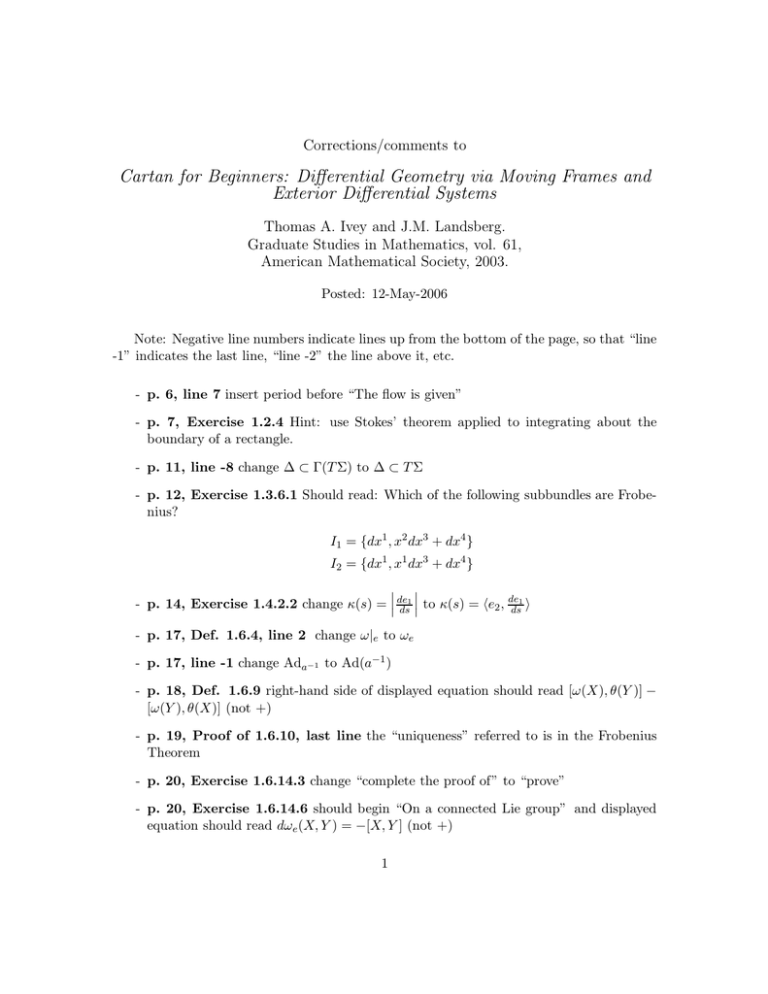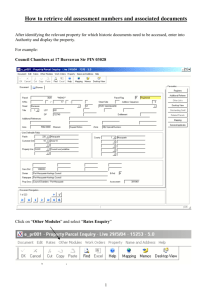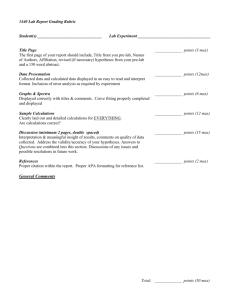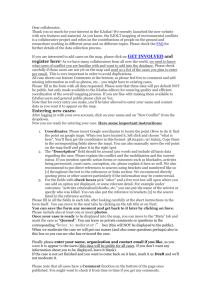Cartan for Beginners: Differential Geometry via Moving Frames and
advertisement

Corrections/comments to
Cartan for Beginners: Differential Geometry via Moving Frames and
Exterior Differential Systems
Thomas A. Ivey and J.M. Landsberg.
Graduate Studies in Mathematics, vol. 61,
American Mathematical Society, 2003.
Posted: 12-May-2006
Note: Negative line numbers indicate lines up from the bottom of the page, so that “line
-1” indicates the last line, “line -2” the line above it, etc.
- p. 6, line 7 insert period before “The flow is given”
- p. 7, Exercise 1.2.4 Hint: use Stokes’ theorem applied to integrating about the
boundary of a rectangle.
- p. 11, line -8 change ∆ ⊂ Γ(T Σ) to ∆ ⊂ T Σ
- p. 12, Exercise 1.3.6.1 Should read: Which of the following subbundles are Frobenius?
I1 = {dx1 , x2 dx3 + dx4 }
I2 = {dx1 , x1 dx3 + dx4 }
1
de1
- p. 14, Exercise 1.4.2.2 change κ(s) = de
ds to κ(s) = he2 , ds i
- p. 17, Def. 1.6.4, line 2 change ω|e to ωe
- p. 17, line -1 change Ada−1 to Ad(a−1 )
- p. 18, Def. 1.6.9 right-hand side of displayed equation should read [ω(X), θ(Y )] −
[ω(Y ), θ(X)] (not +)
- p. 19, Proof of 1.6.10, last line the “uniqueness” referred to is in the Frobenius
Theorem
- p. 20, Exercise 1.6.14.3 change “complete the proof of” to “prove”
- p. 20, Exercise 1.6.14.6 should begin “On a connected Lie group” and displayed
equation should read dωe (X, Y ) = −[X, Y ] (not +)
1
- p. 22, Exercise 1.7.2.2 change f = xn to f = z n
- p. 25, line 1 referenced equation should be (1.2.6), not (1.2.7)
- p. 25, 3 lines before Remark 1.8.3 change d(t) to dt and ω23 +τ (t)ω 1 to ω23 −τ (t)ω 1
- p. 26, Exercise 1.8.4.3 assume a, b 6= 0
- p. 27, line -2 add v(q) = 0
- p. 28, line 12 between 1 and dim M (not between 1 and dim N )
- p. 29, line 1 J k (M, N ) (not J k (M.N ))
- p. 29, line -2 c dx3 (not e dx3 )
- p. 30, line -5 1 ≤ i, j ≤ m − n (not 1 ≤ i, j ≤ n − m)
- p. 32, Exercise 1.9.16(a) Change question to
∂
∂
“At which points is
∧ · · · ∧ n an integral element?
1
∂x
∂x
∂
∂
What about
∧ ... ∧ n? ”
∂y 1
∂y
- p. 42, Exercise 2.2.2.4(c) t(v) = sin(v), not t = sin(v)
- p. 42, Exercise 2.3.1.1 change k1 to |k1 |
- p. 42, Exercise 2.3.1.2 Hint: differentiate ω13 = k1 ω 1 and ω23 = k2 ω 2
- p. 42, Exercise 2.3.1.3 displayed equation should read
[X1 , X2 ] = −
k2,1
k1,2
X1 −
X2
k1 − k2
k1 − k2
- p. 43, Exercise 5 Displayed equation should read
−k1 k2 =
1
2
2
((k1 − k2 )(k2,1,1 − k1,2,2 ) − k1,2 k2,2 − k2,1 k1,1 + 2(k1,2
+ k2,1
)).
(k1 − k2 )2
- p. 45, displayed eqn. above (2.11) change ωja = haij ω j to ωia = haij ω j
- p. 45, eqn. (2.12) h̃aij instead of h̃ai j
- p. 47, Prop. 2.5.3 hII(v, w), e3 i instead of II(v, w)
2
- p. 49, displayed equation last line in displayed equation should be numbered, and
reference in lines below should be to this equation, not (2.6).
- p. 49, line -16 should read “bijective linear maps” (not “linear maps”)
- p. 51, Exercise 2.6.6 change η k to η k two times
- p. 51, paragraph below 2.6.7 change En+s to En+r two times, to avoid confusion
with section s.
- p. 52, proof of 2.6.12, line 1 reference should be to Theorem 1.6.10, not 1.6.11
- p. 54, Exercise 2(e) First displayed equation should read
∇α = (dai − aj ηij )⊗η i ∈ Γ(T ∗ M ⊗T ∗ M ).
One way to check the minus sign is to note that IdT = η i ⊗ei and use the Leibniz rule
to verify that ∇(IdT ) = 0.
- p. 56, second displayed equation The proper definition of the Laplacian has more
complicated signs. One definition is to let δ = (−1)n(k+1)+1 ∗d∗ and define ∆ = δd+dδ.
The introduction of δ is natural because δ is the adjoint of the operator d with respect
to the L2 -inner product on forms on a compact manifold.
- p. 56, Exercise 2.6.18 The sign error above makes for sign errors here, also, more
is needed to do part (c) than discussed in the text.Finally, add the additional exercise
to show that with
P respect to an orthonormal framing e1 , . . . , en on a Riemannian
manifold, ∆f = i fii − df (∇ei ei ).
- p. 57, line 8 u(x1 , . . . , xn ) instead of u(x, y)
- p. 57, line before Exercise 2.6.19 ∂x and ∂y should be read as ∂/∂x and ∂/∂y,
respectively
- p. 57, Exercise 2.6.19(a) Displayed equation should be K = −∆u. One obtains
the expression in the book if one uses the Laplacian with respect to the flat metric on
R2 with coordinates x, y. The remark following the exercise is valid for the Laplacian
with respect to the flat metric.
- p. 59, first displayed eqn. should read
0
1
d(x, T, N, B) = (x, T, N, B)
0
0
3
0 0
0
0 −κ 0
ds.
κ 0 −τ
0 τ
0
- p. 59, (2.19) should read
0 0
0
0
1 0 −κg −κn
ds
d(x, T, ǫ, e3 ) = (x, T, ǫ, e3 )
0 κg
0
−τg
0 κn τg
0
- p. 59, line -4 Change κg (c) = ∇c′ c′ to ∇c′ c′ = κg ǫ here, and in Exercise 2.8.1.3 on
page 60.
- p. 60, Exercise 2.8.1.1 change first displayed formula to κg = hII(T, T ), e3 i, and
change second displayed formula to τg = hII(ǫ, T ), e3 i
- p. 63, picture Picture is mis-labelled; the curves should be labelled in counterclockwise order, and δ1 should be the angle between the tangents to C1 and C4 , etc.
- p. 64, first displayed equation should read
Z
Z
X
κg ds −
δi
K dA = 2π −
∂R
R
i
- p. 64, Exercise 2.9.4.3 To do this exercise, you need to use the higher-dimensional
version of the Poincaré Hopf Theorem; see p.446 in Spivak (reference [182] in the
bibliography) for further details.
- p. 65, displayed equation and below Replace Pfaff(Θ)dV by Pfaff(Θ) five times.
- p. 68, Exercise 2.10.4 The displayed equation for Q should have the vector (ω 1 , ω 2 )
multiplied on the left of the matrix, as well as on the right.
- p. 68, last displayed equation change t s h11 to 2t s h11 and change t s h22 to 2t s h22
in this matrix
- p. 72, line -3 gPk instead of gPk g−1
- p. 75, last displayed eqn. |Kx | instead of Kx and {x} instead of x under lim.
- p. 78, line 2 Replace line with: “with FPV , the set of bases of V . We consider FPV
as a frame bundle over PV , because (e1 mod e0 )⊗e0 , . . . , (en+a mod e0 )⊗e0 is a basis
of T[e0 ] PV . Given M n ⊂ PV ...”
- p. 79, displayed eqn. after Exercise 3.2.8 change ẽν to ẽµ in third line
- p. 79, line -2 change ω̃ α to ω̃0α
4
- p. 79, last displayed equation should read
µ
ν
q̃αβ
= h00 gβα gαδ hµν qγδ
- p. 84, line -16 change “rank one matrices” to “rank one matrices up to scale”
- p. 84, line 3 above 3.3.6 PW instead of BP W
- p. 85, Exercise 3.3.8.3 change “rank one and traceless matrices” to “rank one
traceless matrices, up to scale”
- p. 88, above (3.2) add: Here and in what follows we identify Fs+1,t+1 (V ) with the
space of Ps ’s contained in Pt ’s contained in PV .
- p. 89-90 To avoid confusion rename f = dim F as φ = dim F (5 instances).
- p. 94, line 8 change 3.3.82 to 3.3.8.2.
- p. 96, Exercise 3.5.3.2 change F2 to F 2 .
- p. 96, Def. 3.5.4 change N2x to N2,x in two places
- p. 96, below Def. 3.5.4 add: Let T (k) M denote the vector bundle defined over
(k)
(k)
general points of M whose fiber at x ∈ M is (T̂ x M/x̂)⊗x̂∗ , so in particular T x M ⊂
Tx PV is a vector subspace.
- p. 97, k-th fundamental form paragraph change S k Tx M to S k Tx∗ M ; in displayed
(k−1)
(k)
equation, change X to M , change FFx
to FFx and change S k−1 to S k
∗ to N ∗
- p. 97, Notation above Exercise 3.5.10 change Nk,x
k−1,x
- p. 97, (3.11) insert right parenthesis before “mod”
- p. 99, line 3 replace paragraph with: Recall that we may identify GL(V ) ≃ FPV as
sets. If X = G/P ⊂ PV is homogeneous for some group G ⊂ GL(V ), we may further
identify G with a subbundle of FPV and work with this subbundle.
- p. 99, second display change PS k to S k
~ sj = e1 ∧ ... to E
~ sj = (−1)j−1 e1 ∧ ...; change “and
- p. 99, line -4 and line -2 change E
so on”to “and so on with appropriate signs”
- p. 108, first displayed eqn.There are terms missing from this formula. The following
correction was kindly provided by Colleen Robles.
Recall that we use S to denote cyclic summation. If Ta1 ...ak and Ub1 ...bℓ are symmetric tensors, let Sa1 ...ak ,b1 ...bℓ Ta1 ...ak Ub1 ...bℓ denote the symmetrization of the product.
5
(This is a summation over the
k+ℓ
k
elements of the symmetric group Sk+ℓ that
symmetrize the product.) For example, Sa1 ...ak ,b = Sa1 ...ak b and Sab,cd = Sabc · Sbd .
With this notation in place, let X n ⊂ Pn+s and fix index ranges 1 ≤ a, b ≤ n, and
n + 1 ≤ u, v ≤ n + s. Assume that p ≥ 2, and set p = 2q if p is even, and p = 2q + 1
if p is odd. Then the coefficients of Fp+1 are given by
rau1 ...ap b ω0b = − drau1 ...ap − (p − 1) rau1 ...ap ω00 − rav1 ...ap ωvu
+ Sa1 ...ap (p − 2) rau1 ...ap−1 ωa0p + rau1 ...ap−1 b ωab p − qaup b rav1 ...ap−1 ωvb
p−2
X
−
rau1 ...ak b ravk+1 ...ap + rauk+1 ...ap b rav1 ...ak ωvb
Sa1 ...ak ,ak+1 ...ap
k=q+1
+
(k − 1) rau1 ...ak ravk+1 ...ap
+ (p − k − 1) rauk+1 ...ap rav1 ...ak ωv0
− (p + 1 mod 2) Sa1 ...aq ,aq+1 ...ap (q − 1) rau1 ...aq ravq+1 ...ap ωv0
u
v
b
+ ra1 ...aq b raq+1 ...ap ωv ,
u are the components of the projective second fundamental form. Note that
where qab
the last term appears only when p is even.
- p. 110, 2nd paragraph change n+a+1
−n to n+a+2
−(n+1) and change n+a+1
−
2
2
2
n+1
n+a+2
n+1
n − 2 to
− (n + 1) − 2
2
- p. 147, Exercise 4.1.8 add new Exercise: Explicitly calculate A(1) when A is the
tableau for the Cauchy-Riemann equations.
- p. 148, line 1 “determine” instead of “determing”
- p. 148, (4.7) note that 2 ≤ σ ≤ n
a C b pc .
- p. 148, last line last equation should read ... = Cσb
ρc 11
- p. 152, (4.15) change “solution to (4.14)” to “solution to (4.14)”
- p. 156, displayed eqn. on last line, change s1 − s to s − s1
g C
- p. 159, Theorem 4.6.12 switch the roles of dim ΞC
A + 1 and deg(ΞA ).
- p. 164, Exercise 5.1.2 change “Show that there exist” to “Show that locally there
exist”
6
- p. 173, lines 8-9 change “tableau A(1) associated to (5.7)”to “tableau A(1) associated
to (*)”where (*) is the last equation on p. 172.
- p. 174, line 1 change “there exist” to “there locally exist”
- p. 174, line 8 Aaǫi (instead of Aaiǫ )
- p. 174, Remark 5.5.2 Replace with: “Let B = {Bari vi ⊗wa } ⊂ V ⊗W ∗ denote the
annihilator of A, then if...”now continue with the second line and displayed equation.
Then add, “These equations are sometimes called the symbol relations.”
- p. 175, second displayed equation π1 = dr+(...)dx+... instead of π1 = dr+(...)+...
- p. 176, line -6 “out” instead of “our”
- p. 179, Proposition 5.7.1 start with “Let I be a linear Pfaffian system without
torsion on a manifold Σ.”
- p. 183, Exercise 5.8.2add hypothesis A 6= 0.
- p. 184, line 13 = −ωji ∧ ω j instead of = −ωji ω j
- p. 184, second displayed eqns. dθ 2 = −ω12 ∧ ω 1 ... instead of dθ 2 = −ω12 ∧ ω 1 ...
- p. 188, Example 5.8.14 add the assumption that u 6= 0
- p. 188, last displayed eqns. change ω12 to uω12 on both lines
- p. 189, first displayed eqn. change ω12 to uω12
- p. 192, line 10 change to “K(V ) = S22 (V ) is the intersection of S 2 (Λ2 V ) with the
kernel of the skew-symmetrization map”
- p. 192, line 15 precise reference is Exercise A.6.16
- p. 195, line below (5.25) {v hξ }⊥ instead of {v hξ }
- p. 196, second to last displayed eqns. change ω k to ω j on second line
- p. 211, proof of 6.1.19, line 2 change π(U ) to σ(U )
- p. 218, Def. 6.3.7 Mi instead of M
- p. 218, Prop. 6.3.8, line 3 dWi , dXi ∈ ∆i instead of Wi , Xi ∈ ∆i
- p. 240, diagram change M1 to Σ1
7
- p. 239–240, proof of Theorem 6.5.14 Mr. Kazuhiro Shibuya (Hokudai University) has pointed out that the proof given for this theorem is incorrect where it is
asserted that “any rank two system inside a three-dimensional Frobenius system is
itself Frobenius”. This is not true; for example, on R4 with coordinates (x, y, p, q), the
Pfaffian system generated by the one-forms dy − p dx and dp − q dx lies in the Pfaffian
system generated by dx, dy, dp, but is not itself Frobenius. This mistake was made
in the course of proving the last assertion in the statement of the theorem, i.e., if a
Bäcklund tranformation exists between a hyperbolic EDS I1 of class k and the wave
equation system on R5 , then I1 is Darboux integrable after at most one prolongation.
We hope to post a simple proof of this assertion here in the near future.
- p. 246, paragraph below 7.1.5 change φ to ϕ two times.
- p. 256, line 6 of Proof of Thm. 7.3.3 f a should be F a
- p. 256, (7.7) To clarify, codimEn Vn (I) means codimEn (Vn (I), Gn (T Σ)).
- p.258–259, Remark 7.4.4 Note that s0 is the same as the rank of the Pfaffian
system.
- p. 259, Section 7.5, line 6 suppress f instead of suppress s
- p. 261, line -6 insert a period after “five-manifold”
- p. 265, line 10 “In general, any” should be replaced by “Sometimes”.
- p. 270, first displayed eqn.
1
λ
instead of λ in front of last vector.
- p 274, Defn. 8.1.13 Replace this definition with: Let G ⊂ GL(V ) be a matrix Lie
group where V ≃ Rn . A G-structure on an n-dimensional differentiable manifold M
is a reduction of FGL to a right G-bundle FG ⊂ FGL .
- p. 275, Exercise 8.1.16 move this exercise to p. 278, just above last paragraph
- p. 276, para. 2, line 3 C ∞ (T M, T E) instead of C ∞ (T M, E)
- p. 286, Exercise 8.4.7 displayed equation should read
d2 y
dy
dy
dy
= Γ122 ( )3 + (2Γ112 − Γ222 )( )2 + (Γ111 − 2Γ212 )( ) − Γ211 .
dx2
dx
dx
dx
- p. 286, Prop 8.4.8 displayed equation should read
dy
dy
dy
d2 y
= A( )3 + B( )2 + C( ) + D
2
dx
dx
dx
dx
8
- p. 295, Example 8.6.4 change “Finsler metric” to “reversible Finsler metric”
- p. 296, Example 8.6.6 This is actually an example of a generalized path geometry,
as defined in the correction to p. 298 below, and should be moved to there, just above
Example 8.6.14
- p. 298, paragraph two change path geometry to generalized path geometry, as the
definition here is slightly more general than the one on p. 295
- p. 300, line 2 below 2nd displayed eqn. replace “is”with “must be”
- p. 313, last line v2 ⊗ v2 should be v1 ⊗ v2 .
- p. 314, Exercise A.1.8.3 should read: ... we define α∧β ∈ Λi+j V by the composition
of the inclusion Λi V ⊗ Λj V ⊂ V ⊗i+j and then the quotient to Λi+j V by (A.3), divided
by i! j!.
Remark : given this annoyance of constant, it would have been better to define (A.3)
1
.
with a n!
- p. 315, line 3 Add the assumption that dim V = k. At the end, add: What happens
if dim V > k?
- p. 322, A.4.8.4 change “then”to “is an n × n matrix then”
- p. 323, A.5, line 4
n(n+2)(n+1)
6
instead of
(n+2)(n+1)
6
- p. 329, line 1 change “R is an R-linear” to “R lies in an R-linear”
- p. 335, B.1.2.2 Since local coordinates are not defined and the problem follows
almost immediately from their definition, this should probably be a remark instead of
a problem.
- p. 335, B.1.2.3 should read T ∗ M = ∪x∈M Tx∗ M , not T ∗ M = ∪x∈M Tx M
- p. 336, B.1.3.1 should read “only on the function f and the value . . . ” not “only on
the value . . . ”
- p. 338, Fancy definition (iii) η should be β
- p. 357, 3.3.15.1, last line change IIX,x to IIX ′ ,x′
We thank Colleen Robles (Univ. Rochester) for providing many corrections.
9




